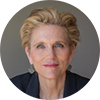Download PDF

Workplace diversity can refer to many things, from race and gender to age and religion. And the process of cultivating diversity is similarly multifaceted: It’s so much more than checking off boxes.
I’d like to discuss one aspect of diversity: underrepresented minorities (URMs) in ophthalmology. Instead of tackling this topic on my own, I interviewed Leslie Jones, MD, chair of ophthalmology at Howard University School of Medicine in Washington, D.C.
Ruth: What exactly is a URM?
Leslie: The acronym typically refers to African-Americans, Native Americans/Alaska Natives, and/or Latinos.
Ruth: Multiple studies demonstrate that increasing diversity is good for business and often leads to better decision-making. How could increasing the numbers of URMs help ophthalmology?
Leslie: It’s well documented that URMs and women ophthalmologists are more likely to practice in underserved communities. Increasing the number of URM ophthalmologists is a strategy for addressing the issue of workforce maldistribution in eye care.
Ruth: What is the value of a historically black college or university (HBCU) like Howard University?
Leslie: There is still unequal access to education and opportunity for URMs. It’s better today, but disparities still exist. We need institutions whose primary purpose is to educate these young people and foster their careers. The mission statement of Howard University includes the sentence, “Particular focus is on the education of disadvantaged students for careers in medicine.”
Ruth: Ophthalmology has a particularly low percentage of URMs. What are some contributing factors?
Leslie: It’s partially a pipeline issue. There simply aren’t enough minority students who are exposed to ophthalmology. URM medical students are more likely to choose a career in primary care. For example, there are 3 HBCUs with medical schools, Howard University, Meharry Medical College, and Morehouse College. Only Howard University has an ophthalmology department and residency program. So, 2 entire URM-enriched pools of medical students are not exposed to ophthalmology.
Ruth: The Academy and AUPO convened a task force chaired by Mildred Olivier, MD, and Susan Forster, MD, to develop a URM pilot program. It is now the MOM (Minority Ophthalmology Mentoring) program, and Keith D. Carter, MD, is its Executive Committee chair. What can MOM accomplish, and what is its vision?
Leslie: Medical careers thrive on mentorship and professional development. Any of us can point to a physician who mentored us and thus helped us craft a vision of our place in medicine. URMs often have less exposure to physician role models and especially to ophthalmologist role models. The MOM program pairs ophthalmologists with undergraduates and medical students interested in ophthalmology.
Ruth: What about unconscious bias in the workplace?
Leslie: Well, dialogue is always a starting point. Ten years ago, we weren’t talking about racism or unconscious bias, but we’ve created an environment where we can discuss these things in professional settings. Unconscious bias is insidious. A presentation at AUPO evaluated deans’ letters and demonstrated a differential in the words used to describe stellar candidates between URMs and ethnic majority candidates. Discussing these findings as a group increases awareness.
Ruth: So, what if a URM isn’t strong academically?
Leslie: Sometimes URM medical students don’t perform as well on traditional measures, which is often a reflection of the disparities in educational opportunities earlier on. So, many medical schools offer academic support. We also need to teach educators that a great ophthalmologist is more than a score—and admissions committees could develop a holistic methodology for evaluating candidates.
Ruth: Thank you, Leslie! You are an inspiration.
Learn more about MOM at aao.org/minority-mentoring, and consider student outreach or mentoring.